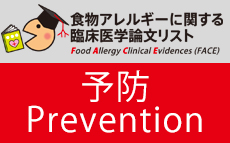Formulas containing hydrolysed protein for prevention of allergy and food intolerance in infants.
更新日:2016年10月21日
| Author: | Osborn DA, Sinn J. |
|---|---|
| Title: | Formulas containing hydrolysed protein for prevention of allergy and food intolerance in infants. |
| Citation: | Cochrane Database Systematic Review. 2003;(4):CD003664. |
| URL: | https://pubmed.ncbi.nlm.nih.gov/14583987/ |
| Abstract: | BACKGROUND: Allergies and food reactions are common and may be associated with foods including adapted cow's milk formulas. Formulas containing hydrolysed proteins have been used to treat infants with allergy or food intolerance, and have been advocated for prevention of allergy and food intolerance in infants. OBJECTIVES: To determine whether use of hydrolysed formulas for infant feeding prevents allergy and food intolerance. If hydrolysed formulas are effective, to determine what type of hydrolysed formula is most effective including extensively and partially hydrolysed formulas. To determine which infants benefit including infants at low or high risk of allergy and infants receiving early, short term or prolonged formula feeding. SEARCH STRATEGY: The standard search strategy of the Cochrane Neonatal Review Group was used including searches of the Cochrane Controlled Trials Register (2003, Issue 1), MEDLINE (1966 - January 2003), EMBASE (1980 - January 2003) and CINAHL (1982 - January 2003) and previous reviews including cross references. SELECTION CRITERIA: Randomised and quasi-randomised trials that compare the use of a hydrolysed infant formula to human milk or cow's milk formula. Trials with >80% follow up of participants were eligible for inclusion. DATA COLLECTION AND ANALYSIS: Eligibility of studies for inclusion, methodological quality and data extraction were assessed independently by each reviewer. Primary outcomes included clinical allergy, specific allergies and food intolerance. Meta-analysis was conducted using a fixed effects model. MAIN RESULTS: Eighteen trials met criteria for inclusion. No eligible trials compared prolonged hydrolysed formula to human milk feeding. Two trials compared early, short term hydrolysed formula to human milk feeding and reported no significant difference in infant allergy or childhood cow's milk allergy (CMA). Two trials compared early, short term hydrolysed formula to cow's milk formula feeding with no significant benefits reported. One large quasi-random study reported a reduction in infant CMA of borderline significance in low risk infants (RR 0.62, 95% CI 0.38, 1.00).Seven studies compared prolonged feeding of hydrolysed formula to cow's milk formula without using co-interventions for allergy prevention. Meta-analysis of 4 studies (386 infants) found a significant reduction in allergy incidence in infancy (typical RR 0.63, 95% CI 0.47, 0.85; RD -0.15, 95% CI -0.25, -0.06). One study reported a significant reduction in allergy incidence in childhood (RR 0.54, 95% CI 0.36, 0.81). Significant reductions were found in asthma prevalence in childhood, eczema incidence in infancy and prevalence in childhood, food allergy prevalence in childhood, and CMA incidence in infancy. All studies enrolled infants at high risk of allergy. Only three trials comparing prolonged hydrolysed formula feeding to cow's milk formula feeding were considered of good methodology. Only one of these trials demonstrated a benefit into childhood (5 years of age). No eligible trials examined the effects of prolonged hydrolysed formula feeding on allergy beyond early childhood. Costs were not reported. Three trials compared prolonged feeding with an extensive to a partially hydrolysed formula and reported no significant difference in allergy incidence in infancy. REVIEWER'S CONCLUSIONS: There is no evidence to support feeding with a hydrolysed formula for the prevention of allergy in preference to exclusive breast feeding. In high risk infants who are unable to be completely breast fed, there is evidence that prolonged feeding with a hydrolysed compared to a cow's milk formula reduces infant and childhood allergy and infant CMA. Further trials are required to determine if significant clinical benefits persist beyond 5 years of age and if there is any additional benefit from use of an extensive compared to a partially hydrolysed formula. Incremental costs of formula and the effect on compliance should be measured. |
| 邦文タイトル: | 準備中 |
| 一般向け要約 | 準備中 |
| 専門医コメント | 準備中 |

